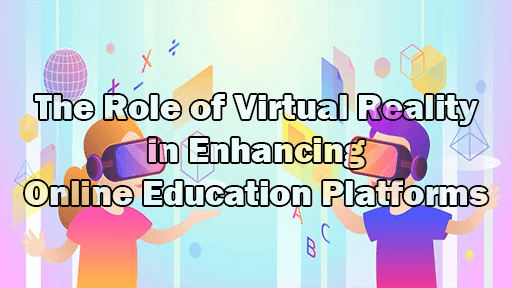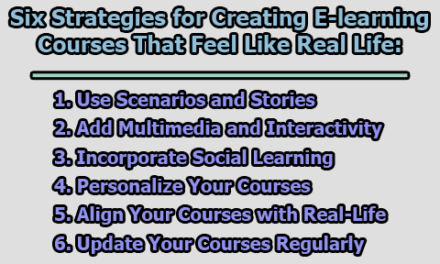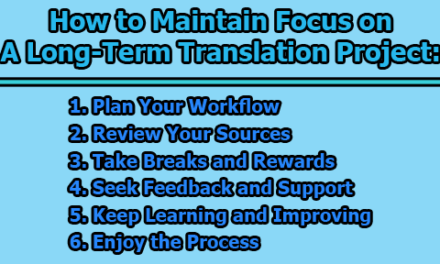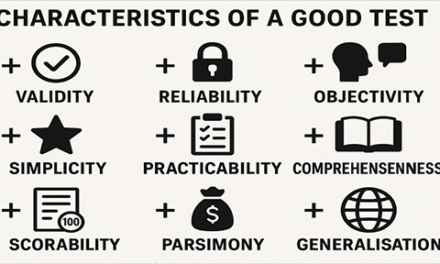The Role of Virtual Reality in Enhancing Online Education Platforms:
Online education has witnessed unprecedented growth in recent years, becoming an integral part of the global educational landscape. As technology advances, the integration of virtual reality (VR) into online education platforms has emerged as a transformative force, promising to revolutionize the way students learn and educators teach. In this article, we delve into the role of virtual reality in enhancing online education platforms.
1. Understanding Virtual Reality in Education: Virtual reality (VR) is a technology that creates a simulated environment, often through the use of specialized hardware such as VR headsets. In education, VR aims to transport learners into immersive, three-dimensional worlds, providing an experience that goes beyond traditional online methods. This immersion allows students to engage with content in ways that mimic real-world scenarios, fostering a deeper understanding of complex subjects. Whether exploring historical landmarks, conducting virtual experiments, or navigating mathematical concepts in a spatial context, the potential applications of VR in education are vast.
The immersive nature of VR can captivate students’ attention and interest, making learning more engaging. Traditional online education often relies on text, images, and videos, which might not fully capture the attention of all learners. With VR, students can actively participate in their learning, interacting with the environment and manipulating objects. This dynamic engagement has been shown to enhance information retention, as learners are more likely to remember experiences rather than passively consumed content.
2. Improved Engagement and Retention: One of the most significant advantages of incorporating VR into online education is its impact on student engagement and information retention. Traditional online learning methods sometimes struggle to keep learners actively involved, leading to decreased focus and lower retention rates. VR addresses this challenge by providing an immersive and interactive environment where students are not just consumers of information but active participants in their learning journey.
Studies have shown that the sensory-rich experiences offered by VR contribute to better information retention. The spatial and contextual memory formed in virtual environments can enhance the recall of learned material. For example, medical students using VR simulations for anatomy studies have demonstrated higher retention rates compared to traditional methods. The ability to explore three-dimensional models of organs and systems in VR allows for a more intuitive and memorable learning experience.
3. Real-world Simulations for Practical Learning: VR’s ability to create realistic simulations opens up new avenues for practical learning in diverse fields. Virtual laboratories, simulations, and field trips provide students with hands-on experiences that might be challenging or expensive to replicate in the physical world. For instance, chemistry students can conduct experiments in a virtual lab, manipulating virtual chemicals and observing reactions in a safe and controlled environment.
The practical applications of VR extend beyond the sciences. Industries such as aviation, engineering, and healthcare leverage VR simulations to train professionals in realistic scenarios. Flight simulators, for example, have been a staple in pilot training for years, and VR enhances the fidelity and accessibility of such simulations. This capability allows learners to practice skills, make decisions, and learn from mistakes in a risk-free setting, ultimately enhancing their preparedness for real-world challenges.
4. Customized Learning Paths: VR technology, coupled with artificial intelligence (AI), enables the creation of customized learning paths tailored to individual student needs. Traditional online education often follows a one-size-fits-all approach, delivering the same content to all students regardless of their learning styles or paces. VR, with the support of AI algorithms, can adapt the learning experience based on each student’s progress, preferences, and performance.
Adaptive learning in VR involves analyzing a student’s interactions within the virtual environment, tracking their strengths and weaknesses. AI algorithms can then adjust the difficulty level, content sequence, or instructional methods to suit the individual learner. This personalized approach not only accommodates diverse learning styles but also ensures that students receive the support and challenges they need to optimize their educational experience.
5. Overcoming Geographical Barriers: Virtual reality has the power to transcend geographical limitations in education. Traditional online classrooms, while offering flexibility, may still be constrained by the physical locations of students and educators. VR brings a sense of presence and connection by creating virtual classrooms where learners from different parts of the world can converge in a shared educational space.
Virtual classrooms in VR environments mimic the real-world interaction found in physical classrooms. Students can communicate with each other, collaborate on projects, and engage in discussions as if they were in the same room. This not only fosters a sense of community but also exposes learners to diverse perspectives and cultural backgrounds. Additionally, guest lectures, expert sessions, and collaborative projects become more accessible, enriching the overall educational experience for students regardless of their geographic location.
6. Enhanced Teacher Training and Professional Development: Virtual reality extends its transformative impact beyond student learning to the realm of teacher training and professional development. Educators can leverage VR simulations to hone their teaching skills in a risk-free and controlled environment. For example, VR scenarios can replicate challenging classroom situations, allowing teachers to practice effective classroom management, adaptability to diverse student needs, and innovative teaching strategies.
Furthermore, VR can facilitate collaborative professional development sessions, enabling teachers from different locations to engage in simulated workshops, share best practices, and collectively enhance their teaching methods. This immersive training not only improves the skills of individual educators but also contributes to the overall quality of education by fostering a community of well-prepared and adaptable teachers.
7. Addressing Accessibility and Inclusivity: Incorporating virtual reality into online education platforms opens up possibilities for addressing accessibility challenges and promoting inclusivity. VR applications can be designed with features catering to different learning needs and abilities. For instance, subtitles, sign language interpretation, and audio descriptions can be integrated into VR experiences to make content accessible to students with hearing or visual impairments.
Moreover, the customizable nature of VR allows for the creation of interfaces that accommodate various learning preferences. Students can adjust the pace of instruction, choose alternative formats for content presentation, or utilize assistive technologies seamlessly within the virtual environment. By prioritizing accessibility, VR contributes to creating an inclusive educational landscape where all students, regardless of their physical or cognitive abilities, can actively participate and thrive.
8. Ethical Considerations and Challenges: As virtual reality becomes more prevalent in education, it is crucial to address ethical considerations and challenges associated with its implementation. Data privacy is a paramount concern, as VR platforms collect substantial amounts of information about user interactions and behaviors. Strict guidelines and regulations must be in place to ensure the responsible handling and protection of sensitive student data.
Additionally, the digital divide poses a challenge to the widespread adoption of VR in education. Not all students have equal access to the necessary hardware and internet connectivity required for immersive VR experiences. Efforts must be made to bridge this gap, ensuring that all students, regardless of their socioeconomic backgrounds, have equitable access to the benefits of VR-enhanced education.
9. Integration with Emerging Technologies: The synergy between virtual reality and other emerging technologies, such as augmented reality (AR) and artificial intelligence (AI), amplifies the potential of online education platforms. AR can overlay virtual information onto the real world, providing contextual enhancements to the learning experience. AI algorithms, when integrated with VR, can dynamically adapt content, create realistic simulations, and provide personalized feedback to optimize the learning journey.
For example, AR could enhance historical tours by overlaying information about landmarks in real-time, while AI algorithms could analyze a student’s performance in a VR simulation and offer tailored recommendations for improvement. The integration of these technologies creates a holistic and sophisticated educational ecosystem that aligns with the evolving needs and expectations of learners and educators.
10. Future Prospects: The preceding points illustrate the multifaceted role of virtual reality in enhancing online education platforms. Looking ahead, the future holds even more promising prospects for the intersection of VR and education. Advancements in hardware, software, and AI algorithms are anticipated to refine the immersive qualities of VR, making it an indispensable tool for educators worldwide.
As VR continues to evolve, its potential impact on online education includes refined simulations, increased accessibility, and a broader array of subject applications. The challenges associated with VR, such as ethical considerations and the digital divide, must be met with proactive solutions to ensure the responsible and equitable integration of this technology into educational practices.
In conclusion, the integration of virtual reality into online education platforms signifies a paradigm shift in the way we perceive and engage with learning. By fostering engagement, personalization, and inclusivity, VR has the power to create transformative educational experiences that prepare students for the challenges of the future. As technology advances and educational paradigms evolve, the collaboration between virtual reality and online education is poised to redefine the landscape of learning and teaching.
Frequently Asked Questions (FAQs):
What is virtual reality (VR) in education?
Virtual reality in education refers to the use of immersive technologies to create simulated environments that replicate real-world scenarios. It aims to enhance the learning experience by providing interactive and engaging content through VR headsets or other devices.
How does virtual reality improve student engagement and retention in online education?
VR enhances engagement by providing immersive experiences that captivate students’ attention. The spatial and contextual memory formed in virtual environments contribute to better information retention, leading to a deeper understanding of complex subjects.
Can virtual reality be used for practical learning and simulations in online education?
Yes, virtual reality is well-suited for practical learning. VR simulations, virtual laboratories, and field trips provide students with hands-on experiences in a controlled and realistic environment, facilitating practical learning across various subjects and industries.
How does virtual reality enable customized learning paths in online education?
Virtual reality, coupled with artificial intelligence (AI), allows for personalized learning experiences. AI algorithms analyze student interactions, adapting the difficulty level, content sequence, and instructional methods based on individual needs and preferences.
What role does virtual reality play in overcoming geographical barriers in online education?
Virtual reality creates virtual classrooms, enabling students from different geographical locations to converge in a shared educational space. This fosters global collaboration, facilitates communication, and exposes learners to diverse perspectives and cultures.
How can virtual reality be utilized for teacher training and professional development in online education?
VR simulations provide educators with a risk-free environment to practice teaching skills and enhance their adaptability to diverse student needs. Virtual workshops and collaborative sessions enable teachers to share best practices and collectively improve their teaching methods.
How does virtual reality address accessibility and inclusivity in online education?
Virtual reality applications can be designed with features such as subtitles, sign language interpretation, and customizable interfaces to cater to different learning needs and abilities. VR contributes to creating an inclusive educational landscape by making content accessible to students with diverse requirements.
What ethical considerations are associated with the use of virtual reality in education?
Ethical considerations include data privacy concerns, as VR platforms collect significant user data. Strict guidelines and regulations are essential to ensure responsible handling and protection of sensitive student information.
How does virtual reality integrate with other emerging technologies in online education?
Virtual reality synergizes with emerging technologies like augmented reality (AR) and artificial intelligence (AI). AR can provide contextual enhancements, while AI algorithms can dynamically adapt content, creating a sophisticated and personalized educational ecosystem.
What are the future prospects for virtual reality in online education?
The future of virtual reality in online education holds promises of refined simulations, increased accessibility, and broader subject applications. Advancements in hardware, software, and AI are expected to further enhance the immersive qualities of VR, redefining the landscape of learning and teaching.

Library Lecturer at Nurul Amin Degree College










